The post Raksha Mantri Shri Rajnath Singh dedicates to the nation new manufacturing facilities at Bharat Dynamics Limited, Bhanur appeared first on Chanakya Forum.
]]>Addressing the researchers, engineers, technicians and other personnel of BDL, the Raksha Mantri termed the inauguration of the manufacturing facilities as a testament to the commitment of the DPSU towards strengthening the defence sector and realising Prime Minister Shri Narendra Modi’s vision of ‘Aatmanirbhar Bharat’. He also lauded BDL for adopting a positive approach towards self-reliance by manufacturing products indigenously in collaboration with foreign companies, in line with ‘Make in India, Make for the World’ vision. He congratulated the company for preparing an indigenisation plan for the next five years and successfully achieving the target of the first two years.
The RF Seeker Facility, which was virtually inaugurated by the Raksha Mantri, is an integrated Centre for production & testing of RF seekers. Seeker is a critical and technology intensive subsystem which will be used in all future missiles for target tracking. This facility has been established by BDL with an investment of Rs 50 crore. Shri Rajnath Singh congratulated BDL for joining the elite club of select few companies across the globe to have the capability to produce the seekers. He hoped that the facility will play a big role in achieving ‘Aatmanirbharta’ in the field of missile production.
Shri Rajnath Singh exuded confidence that the Warhead facility will diversify the scope of manufacturing futuristic warheads and help in making India self-reliant in this field. With the inauguration of this facility, BDL has taken one more step towards self-reliance as the facility will be used for both its current as well as futuristic missiles.
Sharing his thoughts on the constantly-evolving nature of technology and its growing importance in warfare in changing times, the Raksha Mantri stressed on the need to remain up-to-date on the technological front with indigenous capabilities. He exhorted all defence equipment stakeholders – Armed Forces, scientists, academicians and industry – to develop products/systems while adapting to the ever-evolving situation. He emphasised on strengthening technology forecasting and investing in cutting edge manufacturing & testing capabilities, adding that the inauguration of RF Seeker Facility and Warhead Facility is a right step in that direction.
The Raksha Mantri underlined the importance of developing a long-term partnership between defence manufacturing organisations & academic institutions, moving from ‘Know-how’ to ‘Know-why’. He said, this long-term collaboration will help academia to work on core technological problems and assist R&D institutions to move from ‘theoretical analysis’ to ‘conversion into actual products’. It will be a win-win situation and give a boost to the defence eco-system of the country, he added.
Shri Rajnath Singh commended BDL for working on R&D of third generation anti-tank guided missile, Amogha. He added that the DPSU has been an important part of Integrated Guided Missile Development Programme started under Missile Man of India & former President Dr APJ Abdul Kalam in the 1980s. “The programme reduced our dependence on foreign countries in the field of missile development and sowed the seeds of self-reliance. Dr Kalam once said ‘In this world, fear has no place. Only strength respects strength’. BDL is working with dedication and hard work towards making Dr Kalam’s dreams come true,” he said.
The Raksha Mantri appreciated the vital role being played by BDL in catering to the needs of the Armed Forces, terming its achievements as a proof that the military will continue to induct indigenous systems regularly. He added that various items of BDL find place in the recently-issued three positive indigenisation lists, which will enhance the company’s capabilities besides ensuring faster delivery.
Voicing the Government’s unwavering commitment to overcome obstacles and bring transformative reforms in the defence sector, Shri Rajnath Singh asserted that “making the Armed Forces agile, fit, modern and a world class defence service is our top priority”. He described the AGNIPATH scheme as a revolutionary reform which is in the interest of the country, Armed Forces and the youth. “We studied the defence systems of many countries and finalised our plan by aligning these findings with our ground realities. Indian Air Force has received a large number of applications under the AGNIPATH scheme. Similar response is expected in the other Services as well. Our youth should come forward and take advantage of this golden opportunity to serve the country,” he said.
The Raksha Mantri also spoke of some other reforms such as creation of the post of Chief of Defence Staff, establishment of Department of Military Affairs, increasing private sector participation in defence production and launch of Innovations for Defence Excellence (iDEX) initiative. He urged all stakeholders to enhance their preparedness, invest more in R&D and expand by exploring the international market. He extended all support of Ministry of Defence to BDL in this endeavor.
On the occasion, a Central Storage facility at Visakhapatnam Unit of BDL was also virtually inaugurated by Shri Rajnath Singh. The state-of-the-art facility is equipped with modern storage system consisting of vertical Carousel System, Mechanical Compactor and Motorised Compactor which can cater the entire storage needs of the Unit. The facility has been constructed with an investment of Rs 4.90 crore.
The Raksha Mantri also virtually inaugurated infrastructure facilities (Multipurpose Community Hall, Gymnasium, Science Laboratories at Govt Junior College, nine additional class rooms at Zilla Parishad School, two additional class rooms at elementary school) constructed by BDL in Military Madhavaram village, West Godavari District as part of its Corporate Social Responsibility initiatives. Madhavaram village, which is located near Tedepaligudem, is popularly known as ‘Military Madhavaram’, as it has a large number of persons joining the Armed Forces. BDL, being a DPSU, has adopted this village as part of its CSR and constructed the infrastructure at a cost of Rs 4.5 crore.
A statue of Father of the Nation Mahatma Gandhi was also unveiled by Shri Rajnath Singh at the BDL premises. CMD, BDL Commodore Siddharth Mishra (Retd) and senior civil & military officials of Ministry of Defence were among those present on the occasion.
PIB
The post Raksha Mantri Shri Rajnath Singh dedicates to the nation new manufacturing facilities at Bharat Dynamics Limited, Bhanur appeared first on Chanakya Forum.
]]>The post IAF’s ‘VAJRAYUDHA’ : THE ‘ASTRA’ AIR TO AIR MISSILE appeared first on Chanakya Forum.
]]>A testimony to India’s self-reliance in the Defence Sector and progress in the arena of air-launched weapons was the inking of the Rs. 2971 Crores deal by MoD with Bharat Dynamics Limited (BDL) on 06 June 22 for provision of the Astra Mark I Beyond Visual Range (BVR) AAM for the Indian Air Force (IAF) and the Indian Navy (IN) under the Buy Indian IDDM (Indian Designed, Developed and Manufactured) category for capital acquisitions, as contained in the Defence Acquisition Procedure (DAP)-2020. This category essentially covers the procurement of a product from an indigenous vendor that has been indigenously designed, developed and manufactured with a minimum of 50% indigenous content. IDDM, it would suffice to say, is the most preferred category under the DAP.
India’s Existing AAM Inventory
India’s existing AAM inventory consists mostly of ex-import, short and medium-range missiles. The current inventory of SR AAMs (with engagement ranges upto 30 Km) consists of the Soviet-era Vympel R-73 Short Range (SR) AAM, Israeli Rafael’s Python-4 and Python-5 5th Generation SR AAMs, ASRAAM SR AAM from Europe’s MBDA Missile Systems and the older R550 Magic-II SR AAM from Matra of France, at or nearing obsolescence. The ASRAAM SR AAM is currently India’s leading air-to-air weapon, capable of speeds over Mach 3, with high manoeuvrability, fire-and-forget capability (FFC) and resistance to missile countermeasures.
The IAF’s Medium-range (MR) AAM inventory (BVR AAMs with ranges ≥ 50 Km) consists of, among others, the Israeli I-Derby and the French Mica AAMs, which are set to continue in service into the foreseeable future. The 50 Km range I-Derby MR AAM, in operational service since 2012, is a BVR missile equipped with active radar homing and FFC and has been nominated as the primary AAM for the TEJAS LCA. The Mica fulfils short and medium-range roles due to its unique interoperable Radio Frequency (RF) and Imaging Infra-Red (IIR) seekers, while its thrust vector control unit gives it superior mobility at dogfight ranges. Presently the upgraded Mirage-2000 and the Rafale aircraft mount this AAM. India’s Rafales can also mount the MBDA’s ramjet-powered Meteor BVR AAM. The consequent greater engine power accords faster speeds, longer reach and greater manoeuvrability to the Meteor, resulting in a relatively large no-escape zone and therefore greater lethality.
BrahMos Aerospace has also committed to developing the BrahMos AAM by 2024, which will be primarily focussed towards heavy aerial targets like enemy Airborne Early Warning and Control (AWACS) and other aircraft of similar dimensions.
The Astra BVR AAM
While the development roadmap of the Astra is two decades old, the critical need for a BVR AAM was underlined when, on 27 February 2019, a day after India targeted terrorist camps in Balakot across the Line of Control with air strikes, Pakistani F-16s attempted to engage own aircraft including the Su-30 MKI, the latter scrambled in response to this Pakistani misadventure. While any aerial activity closer than 10 Km to the LC is considered an airspace violation by India, the F-16s fired the AIM-120 Advanced Medium-Range AAM (AMRAAM) which, with a max range of 70 Km (recent upgrades have enhanced engagement ranges to upto 160 Km), was capable of engaging aerial targets on the Indian side while staying well within Pakistani airspace. India’s Su-30s were then equipped with the Vympel R-77 MR AAM which was inferior to the AIM 120 in terms of range, guidance and countermeasures due to the far lesser number of upgrades received for the R-77 as compared to those of the AIM-120. In essence, therefore, was the immediate requirement of a true-blood BVR AAM with advanced guidance, propulsion and countermeasure features.

ASTRA Mounted on Su-30 MKI Prior to Flight:Source-overtdefense.com
Design. The Astra is India’s first indigenous AAM developed by DRDO and manufactured by BDL. The AAM is capable of engaging aerial targets over a wide ambit, from 10 Km to 110 Km, thus making it a versatile air-to-air weapon that is effective in close-in dogfights and for stand-off attacks against strategic targets. The Astra is envisaged to be integrated onto the Su-30 MKI & MiG-29 Air Superiority Fighters, the Light Combat Aircraft TEJAS and the Mirage-2000 Multi-Role Fighter, as also the future indigenous 6th Generation stealth-enabled Advanced Medium Combat Aircraft (AMCA) (briefly covered @ https://chanakyaforum.com/lca-tejas-ready-to-touch-the-skies-with-glory/ ). The Astra is a BVR AAM, featuring multi-mode guidance (Inertial Navigation System {INS} & datalink for mid-course guidance and active radar homing for terminal guidance). The AAM’s active radar seeker can lock on to aerial targets with a radar cross-section (RCS) of upto 5m2 from upto 15 Km away at an aiming angle of upto 45º, thus according greater engagement probability! The AAM is equipped with a smokeless solid-propellant motor capable of propelling it upto Mach 4.5 (faster than any known fighter aircraft) and upto an altitude of 66000 feet. Astra mounts a 15 Kg High explosive (HE) Pre-Fragmented (PF) warhead with a proximity fuze that does not require a direct hit to activate, thus further increasing engagement probability! The AAM has the unique capability of locking on to its target before OR after launch, thus providing significant flexibility to the pilot in aerial combat!
Development. The Astra’s initial external design took a few cues from the Vympel and Matra AAMs in terms of dimensions and contours. Astra hit the drawing board in the early 90s as a result of a feasibility study carried out into development of a BVR AAM, with complementarity then envisaged with the TEJAS Program. The Astra Program was formally sanctioned in 2004 with a budget of Rs. 955 Crores. The Program was not a part of India’s Guided Missile Development Program (IGMDP), though the research pool and expertise were heavily drawn from the latter. The Astra Program was led by DRDO as the principal developer, with assistance from Hindustan Aeronautics Limited (HAL) and Electronics Corporation of India Limited at Hyderabad. Astra was put through ground tests between 2004 and 2012 to validate sub-systems and assemblies including the airframe, propulsion & control systems, multi-mode guidance and night operability. Development trials of the Astra have been carried out with effect from December 2012 from the Integrated Test Range at Chandipur, Orissa, when the AAM successfully intercepted a Pilotless Target Aircraft (PTA), Lakshya, thus validating the propulsion and guidance systems. The initial operational prototype was a relatively heavy SR AAM with a range of 25-40 Km and a weight of 330 Kg. The short, stubby canards of the initial prototype caused problems in control and performance, which were accentuated at high altitudes. In response, the Astra was redesigned two years later with an improved propulsion system and forward-mounted cropped delta-wings. A further redesign took place in 2013 in response to flight failures due to incompatibility between control surfaces. While ground-launched trials are imperative for stand-alone validation of sub-systems, launch from a fast-moving aerial fighter platform, simulating combat conditions, is the true test of operational compatibility. Apropos, the Su-30 MKI was selected for captive flight (CF) and air launch trials, which were carried out multiple times, with the first successful air launch from a Su-30 MKI carried out on 04 May 2014. The fifth air launch was carried out on 19 March 2015, wherein Astra successfully engaged a PTA while negotiating a 30G manoeuvre, thus proving its capability to engage targets within tight turn radii, an essential prerequisite for dogfight engagement! Astra saw operational deployment when it was fired during IAF Exercise Iron Fist on 18 March 2016 at Pokhran, Rajasthan. 2017 saw a series of CF trials wherein the AAM’s existing Russian AGAT 9B1103M active radar seeker was replaced with an indigenous Ku-band seeker developed by the DRDO. The seeker was successfully evaluated along with its Electronic-Counter-Counter-Measure features, which are incorporated to ensure that the AAM is not rendered ineffective by adversary’s Electronic-Counter-Measures. Simultaneous warhead trials and supersonic launch trials also proved successful. On 17 September 2019, DRDO announced that the AAM had successfully intercepted a live target at a range of 90 Km, thus validating its BVR capability!

ASTRA Mark 1 in Flight:Source-swarajyamag.com
Post the above successful validation, the acquisition of upto 250 Astra Mk-1 BVR AAM for IAF and IN at approximately Rs. 7.5 Crore each (as compared to approximately Rs. 16.5 Crores per MBDA Meteor AAM!) was approved in July 2020 by the DAC, with the contract as above being inked soon after. Post finalisation of the contract for the Astra Mark 1, the DRDO is now concentrating on development/testing of the Astra Mark 2, equipped with a dual-thrust pulsed rocket motor, which will enable swift acceleration to high speeds in the ‘boost’ phase followed by steady controlled flight in the ‘sustain’ phase, thus improving accuracy and enhancing effective range to 160 Km. The Mark 2 will also feature improved resistance to jamming and a far higher indigenous content. The Mark 2 should see operational induction within the first half of this decade, as a precursor to fielding of the Astra Mark 3, which will feature a Solid Fuel Ducted Ramjet (SFDR) Motor being developed by DRDO to propel it to 350 Km, making it a true-blood, world-beating standoff BVR AAM. Both Mark 2 and Mark 3 will feature thrust vector control, which will allow positive control over the missile’s flight, thus significantly contributing to mid-air manoeuvrability, especially at lower altitudes to engage close-in targets. DRDO is also working on the Astra IR Short Range AAM, which nose-mounts a passive IIR seeker for terminal guidance, allowing the AAM to autonomously detect, track and lock on to aerial targets at close ranges. The shorter range of the Astra IR means that the missile does not have to be intimately integrated with the aircraft’s avionics and can therefore be used with a larger variety of aircraft, as a complement to the Astra BVR AAM.
How Does the Astra Compare?
The Astra, as an immediate comparison, can be weighed against the US AIM-120C BVR AAM, which arms the Pakistani F-16 Fighter Aircraft and the Chinese PL-15 which arms the JF-17 Fighter and the J-20 Stealth Fighter, the former also in the Pakistan Air Force Inventory.
The AIM 120C enjoys a top speed of Mach 4 and a maximum range of approximately 105 Km, which places it inferior to the Astra BVR AAM on both counts. The weight of the Astra Mark 1 is 154 Kg, which is almost equal to that of the AIM 120C, making them both equally manoeuvrable with tight turn radius. The multi-mode guidance system on the Astra also promises superiority when compared to the AIM 120C. The smokeless propellant on the Astra would also afford lower detectability when compared to the AIM 120C.
The dual-pulse motor of the PL-15 would give comparable acceleration to propel it to a similar max speed of Mach 4.5 and a greater max range in excess of 200 Km. However, the export version, PL-15 E, has displayed a max range of 145 Km, making it inferior to the under-development Astra Mark 2. The Active Electronically Scanned Array (AESA) Radar Seeker of the PL-15 would prove advantageous in target detection and tracking. The PL-15 is however a heavy missile, with weight of over 200 Kg, which would significantly impair manoeuvrability, especially at shorter ranges. It is likely to therefore prove inferior to the Astra in a close-combat situation.
Conclusion
The Astra AAM series of missiles enjoy a future-ready roadmap with the induction of the Mark 1 variant and the testing/development of Astra Mark 2 and 3. The multi-role Astra BVR AAM will give India the leading edge in close combat and stand-off targeting in the region, while playing its role towards reducing the dependency of the IAF on the volatile global aerial weapons market.
The post IAF’s ‘VAJRAYUDHA’ : THE ‘ASTRA’ AIR TO AIR MISSILE appeared first on Chanakya Forum.
]]>The post MoD signs over Rs 2,900 crore contract with BDL for procurement of ASTRA Mk I Beyond Visual Range Air to Air Missile System appeared first on Chanakya Forum.
]]>Till now, the technology to manufacture missile of this class indigenously was not available. ASTRA MK-I BVR AAM has been Indigenously Designed & Developed by Defence Research and Development Organisation (DRDO) based on the Staff Requirements issued by the Indian Air Force (IAF) catering for Beyond Visual Range as well as Close Combat Engagement reducing the dependency on foreign sources. Air to Air missile with BVR capability provides large Stand Off Ranges to own fighter aircraft which can neutralise the adversary aircraft without exposing itself to adversary Air Defence measures, thereby gaining & sustaining superiority of the Air Space. This missile is technologically and economically superior to many such imported missile systems.
ASTRA MK-I missile and all associated systems for its launch, ground handling & testing has been developed by DRDO in coordination with the IAF. The missile, for which successful trials have already been undertaken by the IAF, is fully integrated on the Su 30 MK-I fighter aircraft & will be integrated with other fighter aircraft in a phased manner, including the Light Combat Aircraft (Tejas). The Indian Navy will integrate the missile on the MiG 29K fighter aircraft.
The Transfer of Technology from DRDO to BDL for production of ASTRA MK-I missile and all associated systems has been completed and production at BDL is in progress. This project will act as a catalyst for development of Infrastructure and Testing facilities at BDL. It will also create opportunities for several MSMEs in aerospace technology for a period of at least 25 years. The project essentially embodies the spirit of ‘Aatmanirbhar Bharat’ and will help facilitate realising the country’s journey towards self-reliance in Air to Air Missiles.
PIB Release ID: 1829750
The post MoD signs over Rs 2,900 crore contract with BDL for procurement of ASTRA Mk I Beyond Visual Range Air to Air Missile System appeared first on Chanakya Forum.
]]>The post ‘AKASH’- Boosting India’s Ground-Based Interception appeared first on Chanakya Forum.
]]>The Akash SAM System
The Akash is a medium-range (MR) SAM system with a range of 30 to 70 Km across variants, designed to provide AD to vulnerable areas (VAs) and vulnerable points (VPs) to include military and civilian assets of the country. The SAM system is capable of intercepting and destroying fighter aircraft, Unmanned Aerial Vehicles (UAVs) and incoming air-to-surface/cruise/ballistic missiles. Akash is a shining example of self-reliance and an epitome of public-private sector partnership with over 90% components by cost being indigenous and several PSUs/private manufacturers having contributed to the successful fielding of the system. Akash has been developed by Missiles and Strategic Systems (MSS) Cluster of the DRDO with various laboratories/ establishments of the DRDO responsible for missile integration, launcher development, development of the Rajendra Passive Electronically Scanned Phased Array (PESA) Radar (the primary sensor at Troop level for the Akash) and development of tracked missile carriers. The system is being assembled by Bharat Dynamics Limited (BDL), with critical components, simulators, integrated software & technical support equipment being manufactured by Bharat Electronics Limited (BEL), Electronics Corporation of India Limited (ECIL), Tata Power Strategic Engineering Division (SED) and Larsen & Toubro.
Development and Induction. The Akash MRSAM was among the five missiles to be initially developed by DRDO under the Integrated Guided Missile Program (IGMDP). DRDO commenced design and development of the Akash SAM System in the late 1980s. The system continued to be subjected to extensive system, field and Indian Army (IA)/Indian Air Force (IAF) user trials through the next two decades. The development chronology of the Akash SAM has also been briefly covered in another article https://chanakyaforum.com/mr-sam-boosting-efficacy-of-indias-air-defence/.The IA had sought acquisition of 2000 SAMs for a contract cost of Rs. 12500 Crores, intended to replace its existing arsenal of SA-6 Kvadrat SAMs. The maiden induction of the system into the IA took place in May 2015 as part of raising of two Akash Regiments (now operationalised), with two additional regiments of Akash Prime reportedly ordered in 2019. IAF, on the other hand, had initially sought acquisition of 1000 SAMs @ 125 SAMs per squadron. Order for the first two SAM squadrons for the IAF was placed initially in 2009, with 6 and later 7 additional squadrons ordered in 2010 and 2015 respectively. Maiden induction into the IAF took place in July 2015. Delivery of all squadrons for the IAF, to be deployed in approximately five bases across the country, is scheduled to be completed this year. The SAM system has a total contract cost of approximately Rs. 23,000 Crores, which, as per an MoD statement in 2018, has saved the exchequer approximately Rs. 34,500 Crores in foreign exchange due to the relatively lower cost of the Akash SAM as compared to similar foreign missiles. On 30 December 2020, the Cabinet Committee on Security (CCS) cleared exports of Akash SAM, based on interest expressed by some ASEAN countries, UAE and Belarus.
System Architecture
The Akash is a road-mobile SAM system mounted on a self-propelled (SP) (wheeled/ tracked) Akash Launcher (ASPL). Akash can be deployed in single/multiple battery configurations to provide AD to VAs/VPs. Each Akash Battery is configured with four ASPL with each launcher mounting three SAMs. The simultaneous fire of up to eight missiles per battery is controlled from a Battery Control Center (BCC) with inputs from the Rajendra PESA Battery Level Radar (BLR). In this configuration, with allocation of two missiles per target in ripple-firing mode, upto four targets can be engaged simultaneously, which enhances the kill-probability from approximately 88% to greater than 95%! In the IAF, two batteries are grouped together to form a Squadron, while in the IA, four batteries are grouped together to form an Akash Group, forming part of the integrated AD deployment in a sector/theatre. A four-battery group can provide AD to an area ranging from 3600 Km2 to 5000 Km2, depending on deployment pattern (shape) selected. Both Squadron and Group configurations are controlled from a Group Control Center (GCC), based on a SP platform, which carries out target analysis and allocates targets to BCCs. The GCC is provided early warning inputs from a Central Acquisition Radar (CAR) (a 3D radar developed by DRDO as a joint venture with other PSUs/private firms), which provides three-dimensional inputs including range (distance), azimuth (direction) and elevation (altitude) to the SAM system. The CAR is a medium-range, high-resolution surveillance & tracking radar, mounted on a TATRA high mobility vehicle, which is capable of tracking 150 targets upto a range of 170 km and an altitude of 18 km. The CAR can be deployed in less than 20 minutes, has an array of Electronic Warfare features that make it immune to enemy aircrafts’ self-protection jamming system and can detect low-flying and supersonic targets. Individually deployed batteries which are controlled directly by their BCC are provided targeting inputs from a 2D Battery Surveillance Radar (BSR) (providing only range and azimuth) with a 100 km range. Several support vehicles compliment the Akash SAM System to make it self-sustaining in the field, including the Missile Transportation Vehicle, the Power Supply Vehicles (GPSV and BPSV) and the Engineering Support, Maintenance and Repair Vehicles (GEM/BEM).
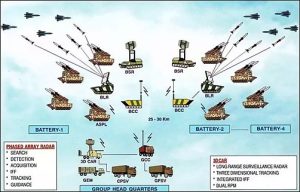
System Configuration of Akash SAM:Source-quora.com

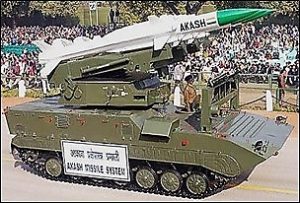
Akash SAM Mounted on T-72/ BMP-1 Based Launchers:Source-airpowerasia.com/armyrecognition.com
Missile Characteristics
The basic variant of the Akash SAM has an intercept range of 25 km. The SAM has a launch weight of 720 Kg with an overall length of 5.78 m. The vector is supersonic and is capable of flying at speeds upto 2.5 Mach, propelled by a ramjet propulsion system, which is activated post burnout of the initial rocket motor, thus enabling the missile to fly at sustained speeds for interception (read more about this @ https://chanakyaforum.com/brahmos-cruise-missile-indias-contender-in-the-supersonic-vector-race/ ). The high kill-probability is offered due to the presence of an onboard command guidance system, allowing the missile to be controlled for the entire duration of flight. The actuator system can carry out movement of fins on the body, which allows the missile to manoeuvre even upto 15G, making the missile capable of tail-chase or lock-on with the target. The 55 Kg warhead is pre-fragmented, allowing easy detonation by a digital fuze, which activates in proximity of the target (thus making a direct hit unnecessary). The Akash is reported to be capable of carrying a nuclear warhead.
Akash Variants
A few events in the chronology of development of further Akash variants are enumerated below:-
- September 2016: The development of the Akash-NG (New Generation) SAM was approved with a funding of ₹470 Crores.
- May 2019: Akash 1S, with indigenous seeker to accurately detect inbound targets, was successfully tested for a range of 30 km, with a 60 kg warhead.
- 23 July 2021: DRDO successfully completes the third test firing of the Akash-NG SAM in deployment configuration.
- 27 September 2021: DRDO test-fires Akash Prime.
Akash-1S. As a precursor on the roadmap towards integrating Akash into the BMD system, the Armed Forces requisitioned a SAM with a seeker that could accurately detect and intercept inbound targets. The Akash 1S with indigenous seeker was thus developed by DRDO and tested in May 2019, with an intercept range of 30 Km and an enhanced 60 Kg warhead. The 1S variant, like the base variant, incorporates command guidance and active terminal seeker guidance, which manifests in higher kill probability.
Akash-NG. The NG variant is a successor to the base variant/Akash 1S and is primarily designed for the IAF, with a shorter reaction time to intercept high speed and rapidly manoeuvring aerial threats with low radar cross-section, such as UAVs and stealth/near- stealth aircraft. The second stage ramjet propulsion of the missile is replaced with a solid-fuel dual-pulse rocket motor, which allows segmented (controlled) burning of the solid-fuel propellant, thus increasing reliability and enhancing range upto 70 Km. The NG variant mounts an Active Electronically Scanned Array (AESA) Multi-Function Radar, which allows electronic steering of the seeker beam without physically moving the antenna. It is also equipped with an improved proximity fuze which can carry out optical detection of the target. The missile is canisterised i.e. stored in controlled conditions in special containers, thus enhancing its longevity and shelf-life. The third test-firing on 23 July 2021 in inclement weather conditions demonstrated the all-weather capability of the variant. The variant is projected to enter operational service next year.
Akash Prime. The Akash Prime variant is primarily designed for the IA and has a maximum range upto 50 Km. It is mounted with an active radio-frequency target seeker with a target lock-on range of approximately 15 Km to enhance kill-probability. This variant has been tailored to suit the high-altitude, low-temperature conditions prevalent along India’s borders, especially along the Line of Control against Pakistan and the Line of Actual Control opposite China-a fact that has prompted the IA to seek acquisition of two additional regiments with this variant. The Akash Prime successfully intercepted and destroyed an unmanned aerial target mimicking an aircraft during its maiden test, thus demonstrating kill capability against UAVs and manned aircraft.
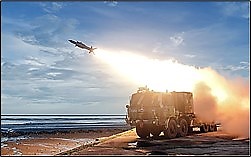
Maiden Test of Akash Prime from ITR Chandipur on 27 September 2021: Source-organiser.org
Regional Comparison
While a plethora of AD systems are available with India’s Northern/Western neighbours for comparison, Pakistan is reportedly banking upon the LY-80 mobile Low to Medium Altitude Air Defence System (LOMADS), designated HQ-16 (Hong Qi-‘Red Banner’) by the People’s Liberation Army (PLA), as a counterpart to the Akash SAM System. It has a maximum range of 40 Km and can fly at Mach 3 to engage targets upto an altitude of 10 Km. It employs semi-active radar homing in the terminal phase of flight. This SAM system relies on an IBIS-150 3D PESA target-search radar (read a brief comparison of AESA/PESA radars @ https://chanakyaforum.com/swathi-wlr-aatmanirbhar-in-elusive-weapon-locating-capability/) with a maximum detection range of 150 Km and battery-level tracking radars (TR) with a range of 85 Km. The TR can detect six/track four targets simultaneously. A battery comprises of a tracking radar and four launchers. Pakistan initially ordered three HQ-16 systems with eight IBIS-150 radars in 2013-14 with a follow-up order for six additional systems in 2014-15. The missile was first inducted into the Pakistan Armed Forces in 2017. The HQ-16 SAM is analysed to be Pakistan’s mainstay for medium-range interception. The improved HQ-16 B with a range of 70 Km is reported to have been offered by China for export. In the PLA, the HQ-16 is considered to fill the gap between the HQ-7 Short Range SAM with a maximum range of 15 Km and the HQ-9/9A/9B Long Range SAM, with a maximum range greater than 300 Km.

LY 80 (HQ-16) LOMADS:Source-armyrecognition.com
Conclusion
The ever-increasing threat paradigm of aerial attacks, characterised by swift targeting and high lethality, has necessitated investment in short-reaction, accurate, lethal and flexible AD weapon systems, capable of neutralising multiple quantitative and qualitative threats. The Akash SAM system, with its range and accuracy, provides an effective foil against manned and unmanned aerial attacks. Further induction of improved variants of this versatile weapon system would prove indispensable for self-reliance in strengthening of India’s AD shield.
************************************************************************************************************************
The post ‘AKASH’- Boosting India’s Ground-Based Interception appeared first on Chanakya Forum.
]]>The post The Dubai Air Show 2021: Opportunities For The Indian Armed Forces? appeared first on Chanakya Forum.
]]>The biennial event has been held since 1989 and has grown from 200 exhibitors and 25 aircraft to approximately 470 exhibitors (including country pavilions/companies/startups) and more than 175 aircraft in its biggest edition this year, which ended with more than 500 aircraft deals cemented globally.
As representation from India, the Indian Air Force (IAF) was invited by the Government of UAE to participate with the Sarang (5x Advanced Light Helicopter ‘Dhruv’- the world’s first four-helicopter aerobatic team!) and Suryakiran (10x British Aero Space Hawk 132 Advanced Trainer Aircraft) Aerobatics Teams. In addition, three Light Combat Aircraft (LCA) TEJAS of the IAF’s 18 Squadron also participated by way of aerobatic and static displays. Air Officer Commanding-in-Chief, Eastern Air Command also visited the IAF contingent on the opening day, as a senior Indian Armed forces representative. The event was preceded by the 10th Dubai International Air Chiefs Conference (DIACC) on 13 November, with more than 70 participant Air Forces, including the IAF.
While it would not be possible to cover all equipment on display at this multi-event show (aircraft displayed in the Static Display can be viewed at the link https://go.dubaiairshow.aero/das21-static-display ), enumerated below are the events associated with India’s representation and certain military equipment which could be of interest to the Indian Armed Forces in the regional context.
India’s Display
While the Sarang Team has previously participated in the Al Ain Grand Prix in UAE in 2005, DAS 2021 was the maiden display for the Suryakirans and the LCA TEJAS. The latter flew under their own propulsion for DAS 2021, while the Sarang Team along with support infrastructure were transported in the IAF’s C-17 and C-130J aircraft for the show.
The Suryakirans combined with UAE’s Al-Fursan Aerobatic Display Team to carry out aerobatic manoeuvres over Dubai, symbolising the understanding between the two Air Forces. The aerobatic display also saw enthralling participation from the Russian Knights and Saudi Arabian Hawks Aerobatics Teams. In addition to the above, the flying displays also had aircraft from the US and Pakistan Air Forces participating in the event.
LCA TEJAS. India’s TEJAS in Final Operational Clearance (combat ready) configuration (read about the TEJAS @ Chanakya Forum https://chanakyaforum.com/lca-tejas-ready-to-touch-the-skies-with-glory/) demonstrated aerial manoeuvres and engaged ‘bogeys’ (simulated enemy aircraft), demonstrating agility and manoeuverability in positive/negative ’G’ situations at high/low speeds, thus showcasing the LCA’s combat effectiveness. Interestingly, Pakistan’s JF-17 ‘Multi Role Combat Aircraft’, scheduled to be pitched against the TEJAS at DAS 2021, pulled out at the last minute without citing any cogent reason, though it appears that this was to avoid inevitable comparisons with the TEJAS, both on the ground and in the air. This is a repeat of the hasty pull-out of the JF-17 from Langkawi International Maritime and Aerospace Exhibition (LIMA) 2019 in Malaysia, where the TEJAS also participated!
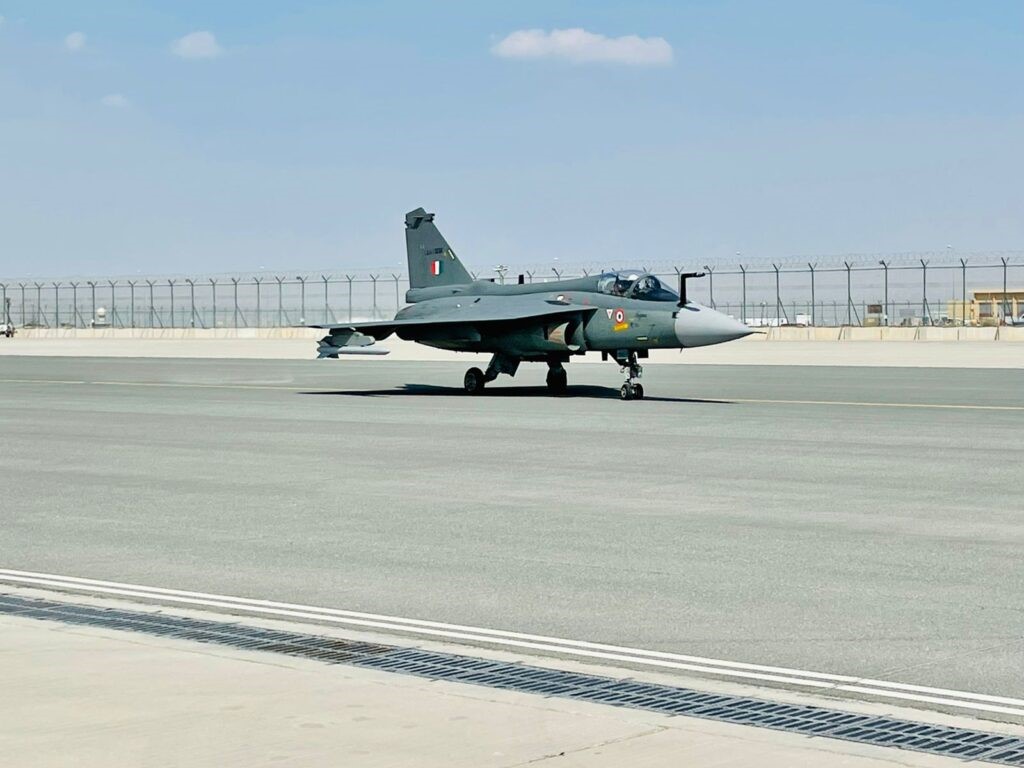
TEJAS at DAS 2021: Source-frontierindia.com
A number of countries have already expressed interest in the TEJAS LCA, wherein the exceptional performance of the aircraft at DAS 2021 has made a strong case for export. Malaysia had earlier issued a Request for Information (RFI) for the aircraft and now looks to purchase 18 aircraft with a possible follow-on order for another 18, in spite of previously shortlisting the JF-17! Similar interest has been shown by Egypt, Sri Lanka and UAE, the latter likely to accept TEJAS with its Israeli ELTA AESA Radar as a testimony to the Abraham Accords- an agreement for collaboration between Israel, UAE and the US, signed in August 2020. A similar RFI has been floated by the US for its jet training system to which HAL has offered the TEJAS trainer version. Similar offers have also been made to Australia and Argentina.
Technology Demonstrated at DAS 2021
Air Superiority/ Multi Role Combat Aircraft
- Russia showcased the Sukhoi (Su)-75 ‘Checkmate’ single engine, fifth-generation (FG), stealth multi-role fighter, for the first time outside Russia. The aircraft is likely to be ready for series production by the middle of the decade and will compete against the US F-35 and China’s Shenyang FC-31 (J-35) FG stealth fighters. The Su-75 mounts five hardpoints for carrying a variety of BVR air-to-air (ATA) and air to surface (ATS) missiles, anti-radiation missiles and bombs. It has a max speed of Mach 1.8 and a ferry range of approximately 3000 km. The thrust to weight ratio is ~1.0 , which is superior to the Eurofighter and the F-35 A & B!

Su-75 Checkmate at DAS: Source-pravda.ru
- The US showcased the F-35 Joint Strike Fighter to back the pending sale of approximately 50 aircraft to UAE, stalled because of US concern over UAE’s collaboration with China, including use of Huawei 5G technology.
Light Attack Aircraft/ Jet Trainers/ Helicopter
- UAE-based Calidus showcased the two-seater B-350 turboprop attack aircraft with full weaponry on its 12 hardpoints- designed for close air support and air strikes in counter-insurgency operations. Embraer showcased the A-29 Super Tucano, which can mount weapons including precision guided munitions on its 5 hardpoints, while US based Textron showcased the Beechcraft AT-6 Wolverine, a light attack and armed reconnaissance turboprop aircraft.

A-29 Super Tucano:Source-builtforthemission.com
- While not a combat platform, China displayed the Falcon L-15 twin seater supersonic jet trainer aircraft, capable of flying upto Mach 1.4. Interestingly, the aircraft has a total of seven wingtip/underwing hard points which can mount ATA/ ATS armament. Boeing showcased its T-7A Red Hawk, an American/Swedish advanced jet trainer produced by Boeing in partnership with Saab. The aircraft can fly just over 1 Mach and may have a modified role as a light attack aircraft.
Russia exhibited the Mi-28 NE Night Hunter Attack Helicopter (AH) with a 270 kmph cruise speed, 435 km range and advanced avionics for automatic detection/tracking of land/sea/air targets. Also showcased was the Kamov Ka-52E gunship, which combines functions of attack, reconnaissance and command helicopters. China displayed the advanced Z19E AH (4 ton class), as also the 4 ton Z9WE Armed Helicopter, along with other rotary-wing entries.

Mi-28 NE Night Hunter: Source-asianmilitaryreview.com
Transport Aircraft
- Brazil showcased the Embraer C-390 Millennium- a medium-sized transport aircraft. With a load capacity of 26 tons, max speed of 988 kmph, operational range (with 23 ton load) of 5820 km, 36000 feet service ceiling and hardpoints for surveillance payloads, the aircraft can be configured to perform various conventional operations. The IAF already operates the Embraer 145 jet for its VIP fleet.
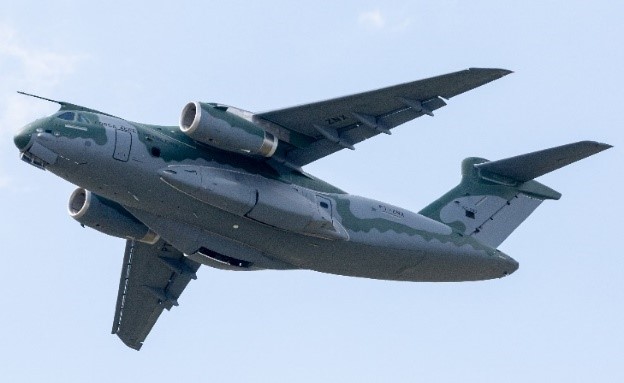
Embraer C-390 Millennium:Source-wikipedia.org
- Boeing displayed the V-22 Osprey, a multi-role turboprop aircraft currently operated by US and Japan, with tilt-rotor capability, suitable for vertical/short take-off/landing (VTOL/STOL). It combines the functionality of a conventional helicopter with that of a long-range, high-speed turboprop aircraft. India could be considering the aircraft for troop insertion in difficult terrain or as a maritime AEW&C platform.
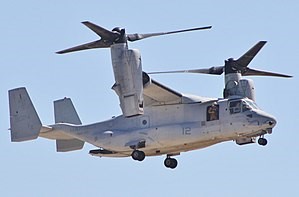
V-22 Osprey:Source-wikipedia.org
- Airbus exhibited the A330 Multi-Role Tanker Transport aircraft, an ATA refueller (AAR), currently in operation in a number of countries in Europe, the Middle East and South East Asia. The refueler has a max fuel capacity of 111 tons and a combat radius of 1800 km with 50 tons of fuel and four hours on-station. The company also showcased the A400 M Multi Mission Airlifter, capable of strategic/tactical lift and as an AAR, with a similar export profile. The aircraft has a range of 6400 km/4500 km with a 20 ton/30 ton payload respectively and can carry, among other loads, 116 paratroopers/ fully equipped personnel.
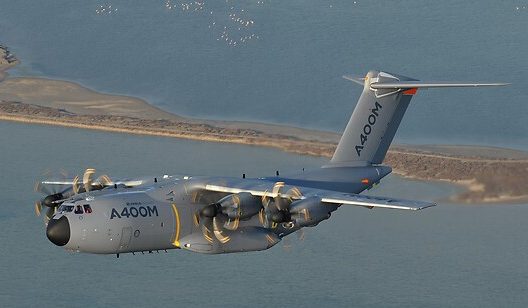
A 400M:Source-airbus.com
Unmanned Aerial Systems
- India’s Defence PSU, Bharat Dynamics Limited showcased an armed quadcopter drone that can be used to engage targets in solo mode or as part of a swarm. The drone has a 32 minute hover time with a payload of upto 1.5 kg, which can be a bomb or a lightweight precision/terminally guided munition with a multipurpose High Explosive Anti-Tank/Fragmentation warhead, effective to a distance of 1 km.
- Skye Air exhibited ‘Skye Air One’- a multi-copter with a load carrying capacity of 5 kg, speed of 40kmph and operational range of 20km. The small drone category finds utility in mounting surveillance payloads and for tactical movement of stores, especially on/ between forward posts.
- Russian Company Kronshtadt exhibited the ‘Orion’ Unmanned Combat Aerial Vehicle (UCAV), which can carry four guided bombs/missiles. The export version, ‘Helios’ is a High Altitude Long Endurance (HALE) UCAV, intended for autonomous operations upto 30 hours at altitudes upto 10,000 m.
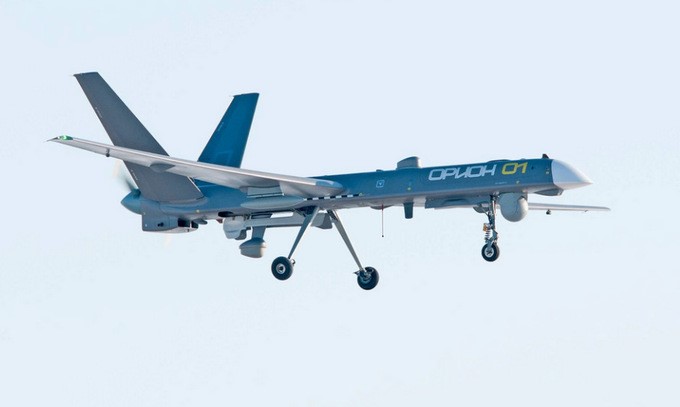
Orion UCAV: Source-military-wiki.com
- UAE’s Edge Group showcased their QX-5 drone, designed for Intelligence, Surveillance and Reconnaissance (ISR) missions, the QX-6 cargo drone and the Reach-S drone, designed for reconnaissance/cargo.
- Saudi Arabia exhibited the ‘Bariq’, a VTOL ISR UAV, capable of swarm deployment.
- US Company Kaman Corporation exhibited ‘Kargo’, a medium-lift logistics UAV. The UAV features a transport pod but can also be used in an external sling load configuration. It can transport payloads of up to 360 kg at distances of upto 970 km.
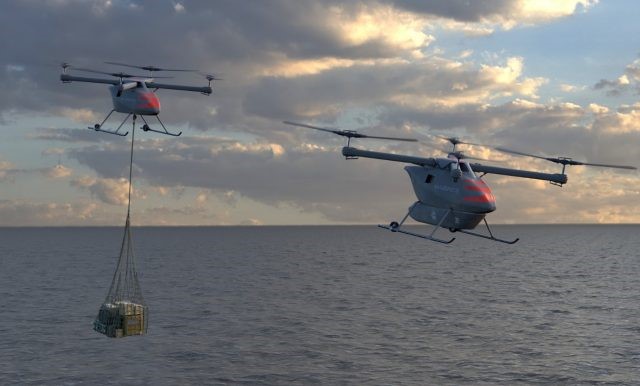
Kargo UAV: Source-Kaman Corporation
Counter- Drone Systems
- Rafael Advanced Defense Systems (RADS) of Israel displayed the ‘Drone-Dome’, a counter-UAS system that can detect, intercept and neutralise hostile drones as small as 0.002 m2, at a distance of upto 3.5 km, with a S-band multi-mission hemispheric radar and a long range surveillance system. The system provides 360º coverage with soft/hard kill options with a RF jammer/Laser Directed Energy Weapon respectively, while offering minimum collateral damage, due to specific jammer bandwidth and an advanced directional antenna.
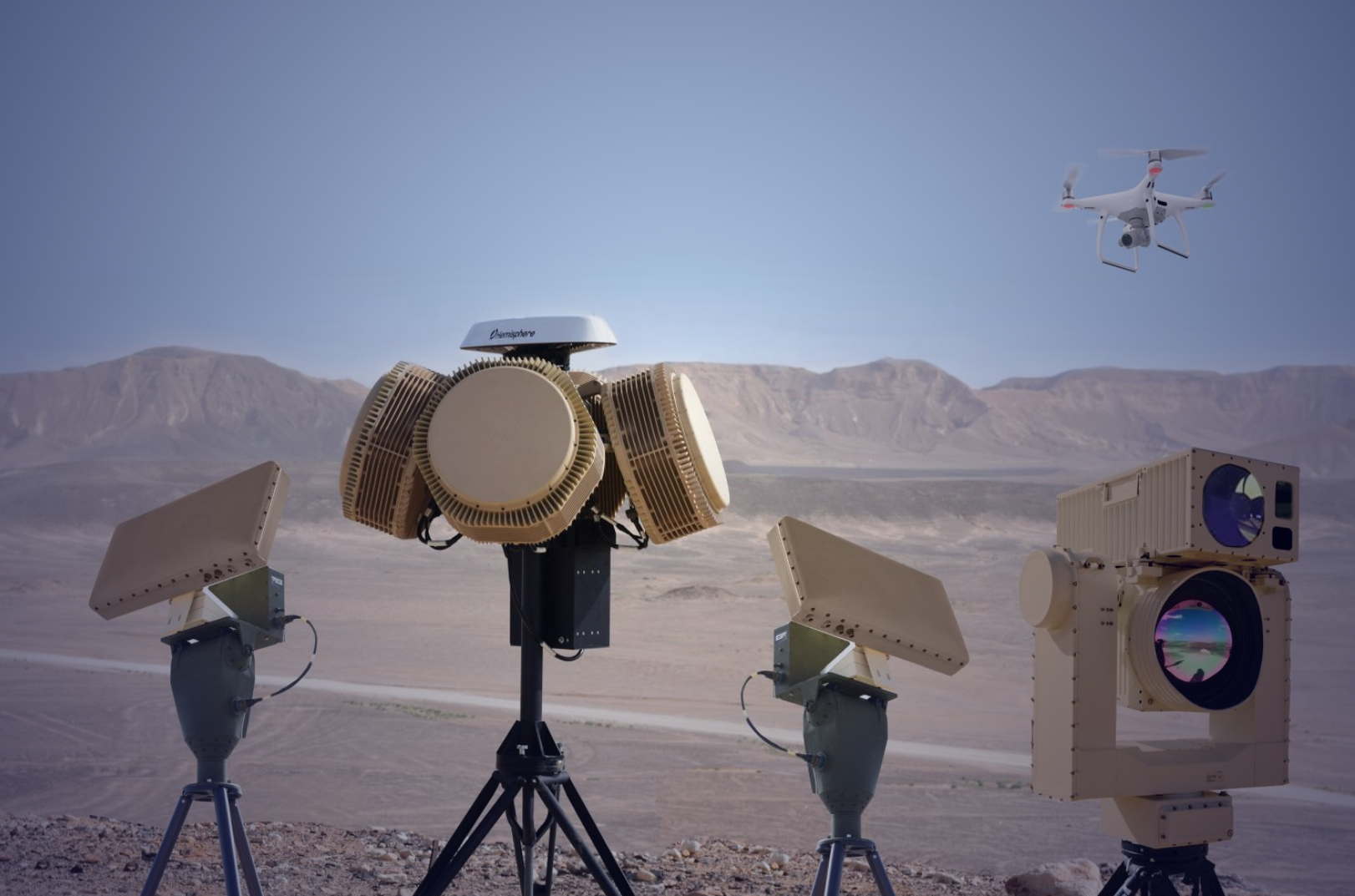
Drone Dome: Source-Rafael.co.il
- US Firm Fortem Technologies exhibited the Drone Hunter (DH), an AI enabled counter-UAV interceptor drone, capable of autonomous detection, pursuit and capture of hostile drones. Multiple DH can be managed by the SkyDome Manager to neutralise simultaneous multiple threats, capturing drones with a net-gun and towing them away.

DH in Action:Source-fortemtech.com
Munitions
In addition to others, Israel’s M/s Elbit Systems exhibited the Rampage long-range ATS supersonic precision-strike missile for use against high value targets and the Sky Striker fully autonomous loitering munition that can locate, acquire and strike operator-designated targets with high precision using a 5 kg warhead installed inside the fuselage.

Elbit Systems Sky Striker: Source-elbitsystems.com
C4 Solutions
- RADS also showcased the Multi-Level Integrated Command, Control and Communications Air Defence (MIC4AD) System, which enables integration and resource management amongst aerial assets and deployed AD systems. This is achieved by coordination and management of the air picture from theatre command level down to AD unit level by integrating multiple situational input layers from civil as well as military sources, allowing AD assets to operate in an open air space alongside routine civil/ military activity.
- M/s Elbit Systems presented the HattoriX Fire Support Solution-a passive/active target acquisition system that uses AI to enable Forward Observers/ surveillance teams to complete sensor-to-shooter loops. The systems runs a photogrammetry algorithm and an Augmented Reality overlay of real-time data to provide automatic fusion of the GIS database/data from a target list/visual feed from an interfaced electro-optical device/C2 information, thus achieving seamless acquisition, generation and transmission of target data.
In addition to the above specific exhibits, a plethora of latest technology relating to AI, 5G, cyber security and automation were showcased by various exhibitors.
Conclusion
DAS 2021 proved to be a marque event that showcased cutting edge as well as battle proven technologies panning physical and electronic domains. The significance and scale of the biggest ever edition of the show was underlined by the fact that this was the first global airshow held in the ‘post- pandemic’ period. Countries and Armed Forces around the world, including India, which had a substantial presence, would do well to identify niche technologies displayed in order to aptly plan future export, acquisition and development road maps.
The post The Dubai Air Show 2021: Opportunities For The Indian Armed Forces? appeared first on Chanakya Forum.
]]>The post PM Modi attends ‘Rashtra Raksha Samparpan Parv’ in Jhansi, Uttar Pradesh appeared first on Chanakya Forum.
]]>The Prime Minister also laid the foundation stone of the 600 MW Ultramega Solar Power Park at Garautha in Jhansi. It is being constructed at a cost of over Rs 3000 crore, and will help provide the dual benefits of cheaper electricity and grid stability. The Prime Minister also inaugurated Atal Ekta Park in Jhansi. Named after Former Prime Minister Shri Atal Bihari Vajpayee, the park has been built at a cost of over Rs 11 crore, and is spread across an area of about 40,000 square metre. It will also house a library, as well as a statue of Shri Atal Bihari Vajpayee. The statue has been built by the renowned sculptor Shri Ram Sutar, the man behind the Statue of Unity.
Addressing the gathering, the Prime Minister noted the birth anniversary of Rani Laxmibai, the pinnacle of valor and might and said today this land of Jhansi is witnessing the grand Amrit Mahotsav of freedom! And today a new strong and powerful India is taking shape on this land. Prime Minister said he feels pride in representing the birthplace of Rani Laxmibai i.e. Kashi. The Prime Minister also extended warm wishes for the Prakash Purab of Guru Nanak Dev Ji, Kartik Purnima and Dev-Deepawali. The Prime Minister paid tribute to many heroes and heroins for their contribution to the history of valor and sacrifice. “This land has also been a witness to the bravery and military prowess of Veerangana Jhalkari Bai, who was an inseparable ally of Rani Laxmibai. I also bow at the feet of that immortal heroine of the freedom struggle of 1857. I bow to the Chandelas-Bundelas, who wrote immortal tales of Indian valor and culture from this land, who made India proud! I bow to the pride of Bundelkhand, those brave Alha-Udals, who are still a symbol of sacrifice and sacrifice for the protection of mother-land” the Prime Minister narrated.
The Prime Minister also remembered Major Dhyan Chand, son of Jhansi and talked about the renaming of the highest award in sports excellence after the Hockey legend.
The Prime Minister remarked that today, on the one hand, the strength of our forces is increasing, but at the same time, the ground is also being prepared for the capable youth to protect the country in future. The 100 Sainik Schools, which are starting, will work in the coming times to give the future of the country in powerful hands. He said that the government has started admission of daughters in Sainik Schools. In 33 Sainik Schools, the admission of female students has already started from this session. Daughters like Rani Laxmibai will also emerge from Sainik Schools, who will take the responsibility of defense, security and development of the country on their shoulders.
The Prime Minister, who was registered as the first member of NCC Alumni Association, called upon the fellow alumni to come forward in service to the nation and contribute in whatever manner possible.
With the historical Jhansi fort behind him, the Prime Minister said that India never lost any battle due to lack of valor. If Rani Laxmibai had resources and modern weapons at par with the British, then the history of the country’s independence might have been different, he said. The Prime Minister said for a long time, India has been among the largest arms buyer countries in the world. But today the mantra of the country is – Make in India, Make for the world. Today India is working to make its forces self-reliant. Jhansi will be a major player in this enterprise, he added.
The Prime minister said events like ‘Rashtra Raksha Samparpan Parv’ will go a long way in creating an environment of Aatmnirbharta in the defence sector. He said we need to celebrate our national heroes and heroines in the similarly grand manner.
PIB Release ID: 1773303
The post PM Modi attends ‘Rashtra Raksha Samparpan Parv’ in Jhansi, Uttar Pradesh appeared first on Chanakya Forum.
]]>The post MR-SAM: Boosting Efficacy of India’s Air Defence appeared first on Chanakya Forum.
]]>The MRSAM is the outcome of more than a decade of partnership under the umbrella of a Joint Venture (JV) between the Defence Research and Development Organisation (DRDO) and Israel Aerospace Industries (IAI) and a witness to seven decades of India’s tryst with SAM Systems.
India’s SAM Story
The major milestones in India’s SAM journey are elucidated below.
India’s quest to develop a SAM began with Project Indigo, launched in 1962, as a JV between India and Switzerland to develop an Intermediate Range (IR) SAM. Project Indigo was later discontinued with limited success. Subsequently, in order to boost own AD capabilities, three squadrons of the Soviet SA-2 Guideline, a medium to high‐altitude SAM System developed in the 1950s, were procured. This led to conceptualisation of the curiously named Project Devil, launched in 1972 and overseen by the Defence Research & Development Laboratory (DRDL), with the goal to produce a Short Range (SR) SAM by suitably reverse engineering the Soviet SA-2. Necessary infrastructure for missile testing, development & design was created under this umbrella. The project was however, short lived and cancelled in 1980 due to less than optimal performance of this SAM System in the 1971 Indo-Pakistan War, as also due to internal disputes over ownership, among other reasons. The technical expertise gained was thankfully not completely lost and would later be incorporated in India’s Integrated Guided Missile Program (IGMDP). In the same year, the Indian Air Force (IAF) convinced the Indian Government to acquire the solid-fuelled Pechora SAM System from the Soviet Union. Of particular interest is the fact that the Pechora was designed to provide AD at low-to-medium altitudes and thus complement the SA-2 System.
- 27 July 1983: Under the stewardship of Dr. A.P.J. Abdul Kalam, India announced launching of IGMDP, wherein Trishul, a Low‐Level SAM (LLSAM) and Akash, a MRSAM were among five missiles to be initially developed by DRDL. The first test of Trishul LLSAM was conducted from Sriharikota on 16 September 1985, a mere two years after launching of the IGMDP! The first test flight of the Akash MRSAM was conducted in 1990.
- January 2000: DRDO announced that the ramjet technology and guidance system developed for the Akash MRSAM would lay the ground for development of future missile systems.
- February 2001: India and Israel sign a $270 Million contract for an initial order to purchase seven Barak-1 Ship Point Defence Missile System for the Indian Navy (IN). The Barak-1, a 10 km range interceptor SAM with the capability to simultaneously engage two targets, was to be retrofitted on the Aircraft Carrier Viraat, the Rajput Class Destroyers and later on each of the under-construction P-17A Stealth Frigates (the latter necessitated due to delays in the development of the Trishul LLSAM)- later being replaced by the Barak 8 SAM with Vertical Launch System.
- September 2001: Both Trishul and Akash SAM Systems enter the guided flight trial phase.
- 23 July 2003: India’s then Defence Minister Shri George Fernandes stated that in view of the delays incurred by DRDO in resolving technical issues associated with the Trishul SAM System, the three Services were at liberty to identify foreign SAM Systems for acquisition to meet urgent operational requirements.
- 2005: The simultaneous engagement mode of the Akash SAM was demonstrated, wherein two SAMs successfully intercepted two fast moving aerial targets.
- February 2006: India & Israel signed a JV to develop the Barak-Next Generation (NG) shipborne SAM, evolved from the Barak-1 SAM elucidated above. In July 2007, the MRSAM Project under the same collaboration commenced. Both SAMs have the moniker of Barak-8.
- July 2007: The Cabinet Committee on Security (CCS) accorded formal clearance for the commencement of JV between IAI and DRDO for manufacture of the SAM System.
- Feb 2008: The Government of India announced the closure of the Trishul LLSAM Program, over protracted development delays.
- 27 February 2009: The Government of India signed a JV with IAI to jointly develop the MRSAM with DRDO.
- November 2009: Israel signed a ₹8000 Crores contract for supply of upgraded Barak-8 SAM AD System to India.
- 03 March 2012: Akash SAM was officially inducted into the IAF. In June 2012, the IAF version of Akash SAM with a strike range of 25 km was successfully test fired on manoeuvering targets from the Integrated Test Range (ITR) at Chandipur.
- May 2015: The IA version of Akash SAM was inducted, based on the plan of acquisition of two regiments for the IA.
- 01 September 2015: The Defence Acquisition Council (DAC) cleared the acquisition of seven additional (total order for 15) squadrons of Akash SAM for the IAF.
- December 2015: IN successfully test fires Barak-8 SAM (Naval Version) from INS Kolkata.
- 30 June 2016: Land-based version of Barak-8 (MRSAM) was successfully test-fired for the first time from ITR Chandipur.
- September 2016: The development of the Akash-NG (New Generation) SAM was approved with a funding of ₹470 Crores.
- May 2019: Akash 1S, with indigenous seeker to accurately detect inbound targets, was successfully tested for a range of 30 km, with a 60 kg warhead.
- 2020: On November 13, maiden test firing of Quick Reaction SAM (QRSAM) was carried out from ITR Chandipur. The QRSAM is being developed jointly by DRDO, Bharat Electronics Ltd (BEL) and Bharat Dynamics Ltd (BDL). It has a range of 3 to 30 km and is designed for protection of armoured columns against aerial treats. A month later, on 23 December, the first launch of MRSAM with complete fire unit configuration was carried out from ITR Chandipur. The missile was reported to have achieved destruction of a high speed unmanned aerial target. The fielding of the complete fire unit architecture established the efficacy of the system in the deliverable configuration. CCS cleared the exports of Akash SAM, based on requests from some ASEAN countries, UAE and Belarus on December 30.
- 2021: On February 22, DRDO carried out maiden launch of two VL-SRSAM to test the efficacy of the vertical launch system and maximum/ minimum range. Both missiles successfully intercepted their target. This was followed by IAI successfully tests Barak-8 ER SAM with 150 km range a month later. On 23 July 2021 DRDO successfully completed the third test firing of the Akash-NG SAM and the first deliverable Firing Unit of the MRSAM handed over to the IAF on 09 September.
While there are numerous developments that India is undertaking in the arena of SAMs, this article only aims to cover salient features of the MRSAM. Salient details of other SAM Systems in vogue/ under development are also elucidated in the table below.
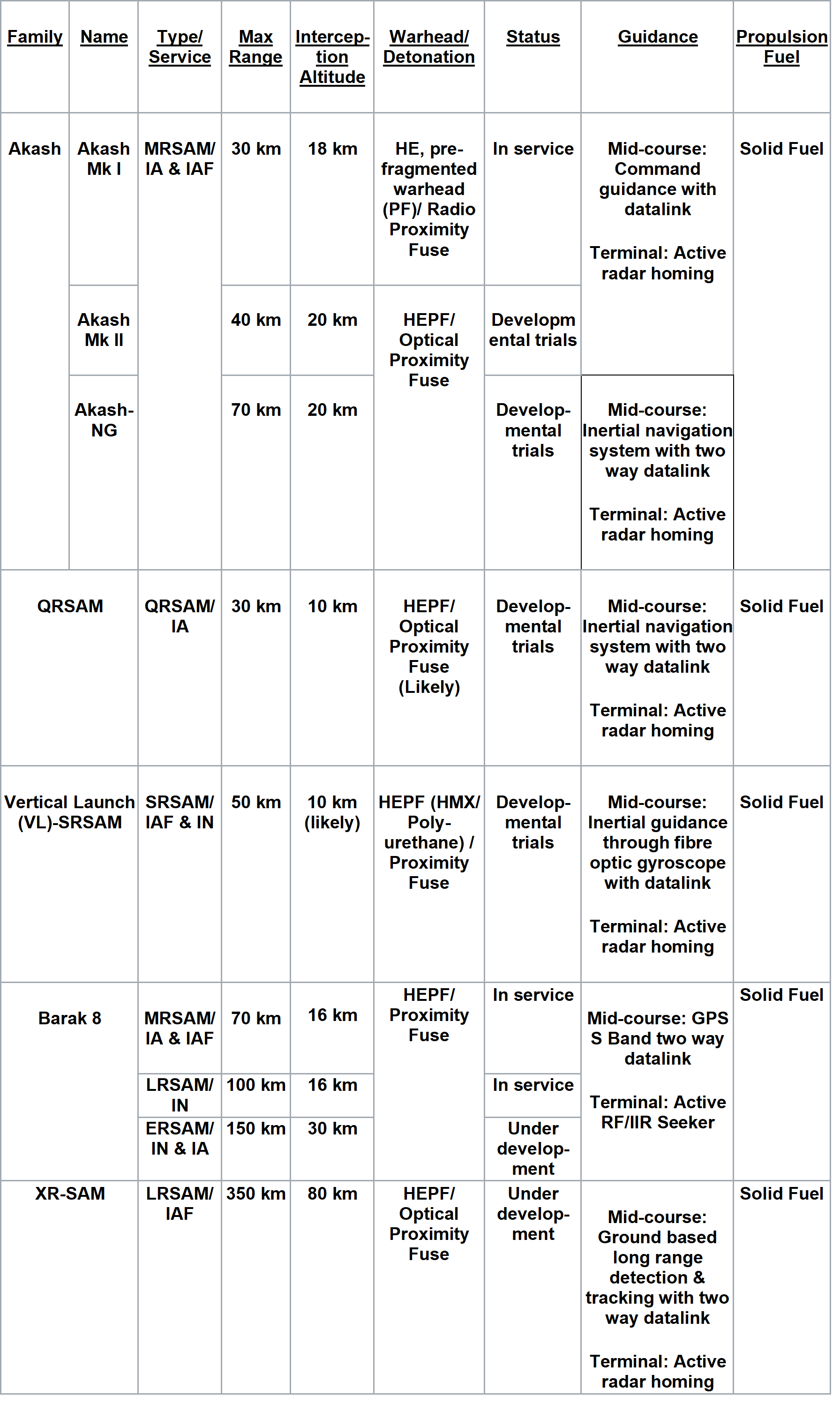
MRSAM
The MRSAM is the land-based version of the Barak-8 SAM (the Naval version being the Long Range {LR} SAM, acquired to fill the IN’s gap in medium to long range AD beyond 50 km) and is developed jointly by IAI and DRDO, as a result of a JV which commenced in 2007.The MRSAM has a range of 70 km, which essentially fills the medium range AD interceptor gap in the inventory. The missile has close to 70% indigenous content. It is a supersonic interceptor, capable of speeds upto Mach 2, is 24 hours capable and can engage multiple targets simultaneously, in all weather conditions. The MRSAM provides Point as well as Area AD for ground assets against a wide range of threats including fighter aircraft, UAVs, helicopters, guided/ unguided munitions and cruise missiles. Initially, the weapon was developed as a shipborne missile system meant for the IN, which later evolved into the land based MRSAM AD System. The MRSAM System is likely to be employed for Area AD in the wake of strike formations (which would have the QRSAM Systems moving ahead) or for AD of Vulnerable Areas. The IA has ordered three/five regiments of MRSAM while the IAF is to acquire 9 squadrons, for an approximate initial cost of ₹16,800 Crores and ₹10,000 Crores respectively. A contract for an initial amount of ₹2600 Crores was reportedly inked with BEL in 2018, for equipping seven ships of the IN with the LRSAM AD System. In 2019, IAI reportedly signed a ₹6,800 Crores agreement with Cochin Shipyard and IN to provide maintenance and other services for the SAM and its sub systems.
System Architecture. Each MRSAM System (fire unit) is network-centric and consists of a command post or combat management system (CMS), a Multi-Function Surveillance and Threat Alert tracking Radar (MFSTAR), SAMs and three mobile launchers. The mobile launchers are used to transport, erect and launch up to eight canisterised missiles, held in two stacks. It can fire the missiles in single or ripple firing modes from the vertical firing position. The CMS is responsible to identify and track the threat using the tracking radar. The system carries out Identification Friend or Foe (IFF) while calculating the distance between the target and the launcher. This target information is then transmitted to the mobile launcher for engagement. The Missile Reloader Vehicle (RV), Field Service Vehicle (FSV) and mobile power systems (MPS) for radar/ CMS are also part of the system.

MRSAM System Architecture: Source- military-today.com
Guidance, Warhead and Propulsion. The MRSAM is a nuclear capable SAM with a length of 4.5m and a weight of 276 kg. It is equipped with an advanced active radar radio frequency (RF) seeker, advanced rotating phased array radar, and a two-way data link. The RF seeker, located in the front section of the missile, is used to detect moving targets in all weather conditions. The phased array radar provides a high-resolution air situation picture, while the two-way data link is used for relaying midcourse guidance and target information to the missile. The missile’s explosive warhead mounts a proximity self-destruct fuse and provides high kill probability against aerial targets. The MRSAM is equipped with a dual-pulse solid fuel propulsion system developed by DRDO and incorporates thrust-vector control for directional changes.
Involvement of Indian Industry. BDL is the manufacturer and lead integrator for the MRSAM System and has established a new production facility in Hyderabad to manufacture both MRSAM and LRSAM. The facility is reported to have the capacity to produce 100 missiles a year. Research Centre Imarat (RCI), a DRDO Laboratory specialising in Avionics and Mission Software, among other fields, has spearheaded the joint development of the MRSAM on behalf of DRDO. Under contract with DRDO, Tata Advanced Systems Ltd has designed and manufactured the CMS for MRSAM and is manufacturing the mobile launchers in collaboration with L&T. Kalyani Rafael Advanced Systems (KRAS), a joint venture of Kalyani Group and Rafael Advanced Defense Systems, was contracted to produce and supply missile kits for final integration by BDL. Other firms/ DPSUs involved in the development of the MRSAM include BEL, Elta Systems Israel and other private vendors.
Conclusion
In India’s transition from a heavily foreign-industry reliant Armed Forces’ equipment profile to indigenisation and self-reliance, under the overarching need to keep our Armed Forces at the very cutting edge of operational capability, it may presently be required, at times, to enter into Joint Ventures with established foreign defence equipment manufacturers, when inescapable, to deliver cutting edge Defence solutions, albeit with steadily increasing indigenous content. The MRSAM is an apt example of such an intermediate step in the country’s objective towards achieving complete self-reliance in arming and equipping our Defence Forces.
****************************************************************************************************
The post MR-SAM: Boosting Efficacy of India’s Air Defence appeared first on Chanakya Forum.
]]>The post India’s ATGMs : Lethal Anti Armour Capability appeared first on Chanakya Forum.
]]>ATGMs range in size from shoulder-fired weapons transported by a single soldier, to larger tripod-mounted weapons, which require multiple persons to transport/ fire and on to vehicle and aircraft mounted systems. The broad categorization of ATGM ‘Generations’ are given in succeeding paragraphs.
First Generation ATGMs. First Generation ATGMs (1950s-1960s) were Manually Command Guided onto Line of Sight (MACLOS) missiles, which required to be continuously guided by a stationary operator onto the target using cross- hairs, thus inevitably exposing the operator to enemy action. The first such missile to see combat was the French Nord SS 10 in the early 1950s, which was used by the French, US and Israeli Defence Forces.
Second Generation ATGMs. Second Generation ATGMs (1970s-1980s) were Semi- Automatic Command Guided to Line of Sight (SACLOS) missiles which required a stationary operator to only keep the sights on the target till impact. Guidance commands were automatically sent to the missile via a wire or radio link, or executed by LASER / TV homing in the nose cone of the missile. The Russian Konkurs/9M133 Kornet & French MILAN-2T, all employed by the Indian Army (IA); Pakistan’s Baktar- Shikan, based on Chinese HongJian (HJ- 8) (Red Arrow 8) & US BGM-71 TOW (in use with Pakistan) and US Hellfire are some examples.
Third Generation ATGMs. Third Generation (TG) ATGMs (1990s) are the ‘fire and forget’ class of ATGMs which utilise a nose mounted LASER, Electro-Optical (EO), Infra-Red (IR) or Radar Seeker to guide themselves onto the target. While these missiles lend to autonomy and operator safety, these are naturally more susceptible to Electronic Countermeasures (ECM) than the earlier generations of missiles, which used closed loop guidance. The Chinese HJ-10 Red Arrow, Israeli Spike, India’s NAG & MPATGM and the US Javelin are some examples.
Fourth Generation ATGMs. Fourth Generation ATGMs (present day) are ‘fire and forget’ ATGMs which have greater effective range and use a combination of seekers for guidance. Examples are India’s Stand- Off Anti- Tank Missile (SANT), with a range of up to 20 km and Israel’s Spike Long range (LR) ATGM.
Indigenous ATGM Journey
Post-Independence, the Indian Government constituted a Special Weapons Development Team (SWDT) in 1958 to study and develop guided missile systems. Phase-I under the aegis of the SWDT commenced in 1959 to develop a First-Generation wire-guided ATGM with a HEAT warhead. The project was eventually terminated in 1969 when the IA upgraded its operational range requirements to 2 km. Even though the project met with limited success, the work in this field saw the establishment of manufacturing facilities of guidance & propulsion systems, material manufacture and airframes that was to stand the ATGM missile industry in good stead later.
The 1980s saw the initiation of India’s Integrated Guided Missile Development Program (IGMDP) led by DRDO, which resulted in a number of technology demonstration programs that would become the bedrock for development of indigenous rocket and missile systems. It was under the IGMDP that the project for the Third Generation NAG ATGM was conceived.
NAG ATGM. The NAG (Cobra) ATGM is an umbrella TG ATGM project, developed at a cost of Rs. 300 Crores, under which a number of variants have been produced, as elucidated below. The ATGM is an all-weather, ‘fire-and-forget’, missile which uses tandem, high explosive warheads with improved kill probability. NAG is manufactured by Bharat Dynamics Limited (BDL). Alongside, the NAG Missile Carrier (NAMICA), an indigenously built BMP-2 with additional wheels, nicknamed ‘Sarath’, successfully completed amphibious trials in August 2008. Sarath is equipped with a thermal imaging sight and a laser-range finder for target acquisition and carries a total of 12 ATGMs, with eight in ready-to-fire mode. The IA placed an order for 443 NAG ATGMs and 12 NAMICA Carriers in 2008. A change in qualitative requirements by the IA, however, led to delays in supply of the order. Further upgradation of the sighting system and Imaging Infra-Red (IIR) Seeker as well as work for improvement in the hit capability of the ATGM led to the induction being put on hold. The final trials with a live warhead were successfully completed on 21 Oct 2020 and the ATGM was declared ready for induction into the IA.
- Prospina. The Prospina is the base-variant land-attack version of the NAG ATGM. It is man-portable and can be mounted on the Sarath. The ATGM is equipped with a solid-propellant rocket booster and a separate sustainer motor and has a range of 500m to 4 km. Mid-course guidance is provided with a two-way data link. Terminal homing is provided by IIR and millimetric wave active radar homing (MMW). The ATGM is tipped with an 8 kg tandem-charge HEAT warhead, which is top-attack capable and provides penetration >900m against ERA/ Rolled Homogenous Armour (RHA). The airframe is made of composite material with four foldable wings and four tail fins for in-flight stabilisation. Single shot kill probability (SSKP) of the missile is claimed to exceed 90%.
- HELINA/ Dhruvastra. The Helicopter Launched NAG (HELINA) (IA) or Dhruvastra (IAF), is the air-launched extended range (ER) variant of the NAG ATGM. It can be launched from the Advanced Light Helicopter (ALH) Rudra/ Light Combat Helicopter (LCH), which have been described in detail @ Chanakya Forum https://chanakyaforum.com/an-indian-helicopter-story/ .The ATGM is guided by an IIR seeker operating in lock-on-before-launch (LBL) mode, a pre-requisite for air-to-ground engagements. The missile has an operational range of 7-10 km and a speed of 230 m/s, with both top-attack and direct hit capability. The HELINA/Dhruvastra underwent a series of multi-mission user trials and were declared ready for induction into the IA and IAF respectively in February 2021.
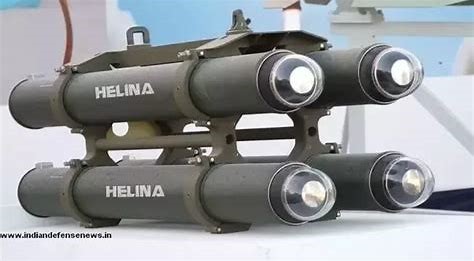
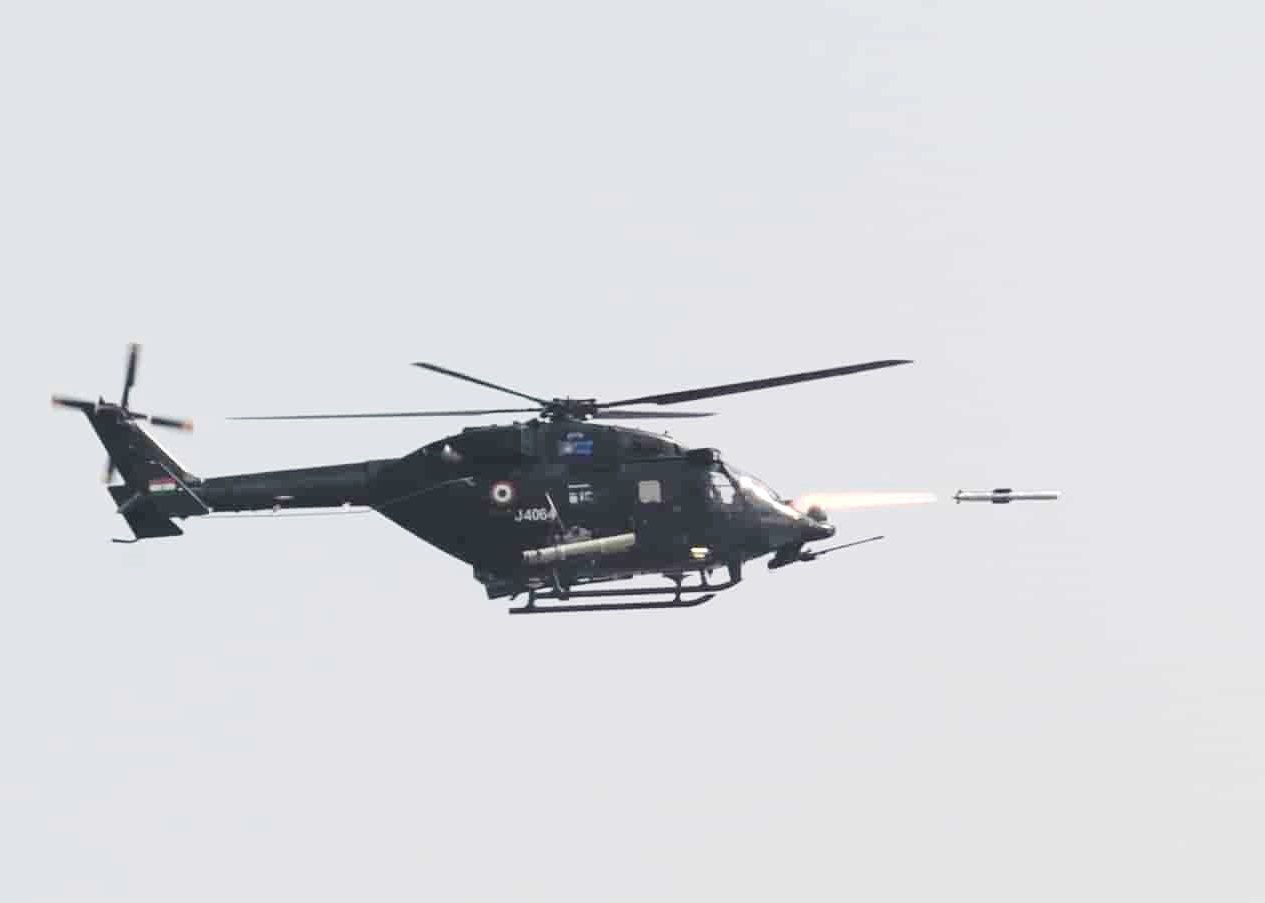
HELINA ATGM, Being Fired from ALH RUDRA: Source-indiandefencenews.in, IA
- MPATGM. The Man Portable ATGM (MPATGM) is a TG ATGM derived from the NAG ATGM and is served by a two person crew. The missile has been developed by the DRDO in partnership with Indian firm VEM Technologies Private Ltd and is being manufactured by BDL. Development was sanctioned by MoD in January 2015. The missile uses IIR guidance and has an effective range of 2.5 Km. A light weight miniaturised IIR seeker that uses Artificial Intelligence for mid-flight correction onto the vulnerable portion of the target has also been developed by BDL with private partnership. The ATGM carries two HEAT tandem warheads and is capable of top-attack. It is powered by a dual thrust solid fuel rocket with blast tube ejection motor-the former serves to initially ‘boost’ the ATGM rapidly to high speed and subsequently to ‘sustain’ it in flight at a slow rate of burn, thus improving accuracy. The ejection motor aids in ‘soft launch’ or non-explosive ejection, allowing the rocket motor to be ignited outside the (collapsible) tripod- mounted launch tube, thus providing safety to the operator and the launcher- an essential feature of a MPATGM. The missile weighs 14.5 Kg while the Command Launch Tube (CLU) weighs 14.25 Kg. User trials were planned for completion in 2020 but were postponed due to the COVID pandemic. The ATGM is slated to replace the MILAN-II and Konkurs ATGMs with the Infantry, Airborne Battalions and Special Forces. On 21 July 2021, the MPATGM successfully underwent its fourth flight test to validate minimum range and in-flight stability, wherein the miniaturised IIR seeker was also successfully validated.
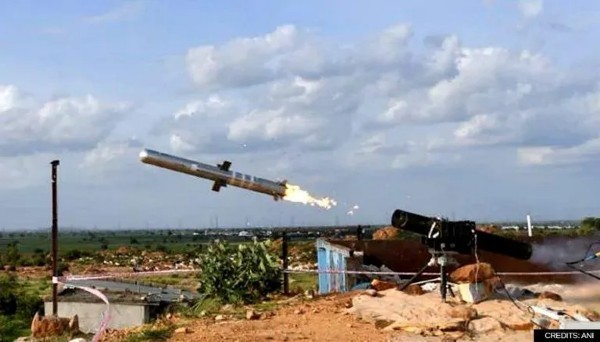
Test Firing of MPATGM: Source-ANI
- SANT. The Standoff ATGM (SANT) is a Fourth-Generation upgraded variant of HELINA, developed for long range anti-armour engagement. It uses dual nose-mounted of EO/ IR and MMW seekers. It has a range up to 20 km with LBL and lock-on-after-launch (LAL) capabilities. It is also reportedly intended to mount the SANT on fighter jets of the IAF and the indigenous Rustom/Ghatak stealth UCAVs, described @ Chanakya Forum https://chanakyaforum.com/indias-tryst-with-uav-from-surveillance-to-strike/. The missile, with its 20 km range, would be superior to the Israeli Spike LR (16 Km) or US Hellfire (11 Km) ATGMs in terms of effective range. DRDO successfully test fired the missile on 19 October 2020.
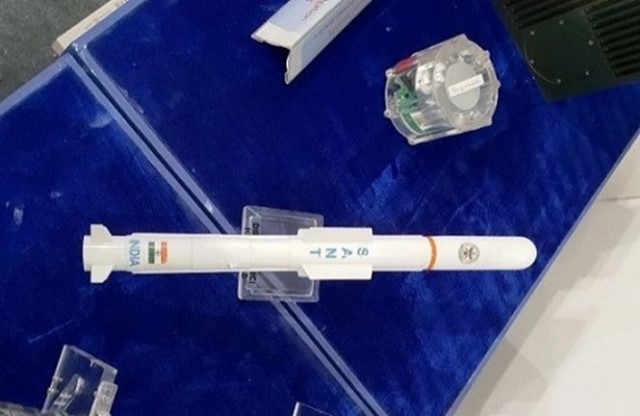
SANT ATGM: Source-DRDO
SAMHO ATGM. The Semi-Active Mission Homing Missile (SAMHO) is a TG cannon-launched ATGM under development by DRDO’s Armament Research and Development Establishment (ARDE) under the Cannon Launched Missile Development Program (CLMDP). The missile uses semi-active LASER homing and is fired from the 120mm rifled main gun of the Arjun Main Battle Tank (MBT). Plans also exist to make it compatible for firing from the 125 mm smooth bore main gun of the T-90 MBT. The ATGM has an operational range of 1.5 to 5 Km. It carries two HEAT tandem warheads designed to defeat ERA of modern MBTs and is also for use against low-flying helicopters. Trial firing was successfully carried out in September-October 2020. The missile is similar to the Israeli LAHAT and the Russian 9M119 Svir cannon launched ATGMs.

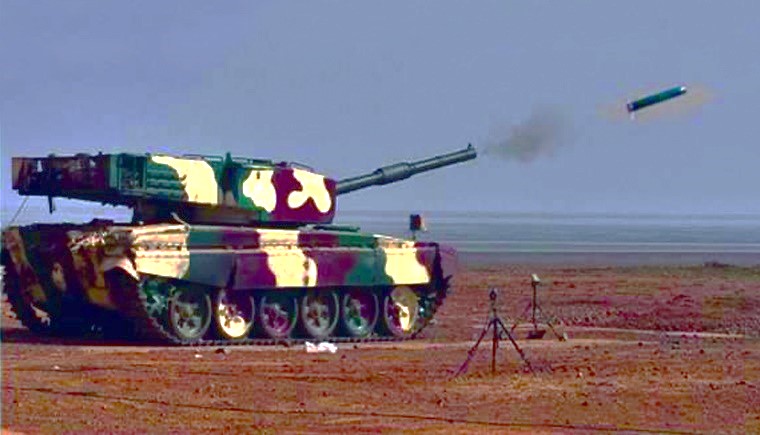
SAMHO ATGM, Being Fired from MBT Arjun: Source-drdo.gov.in, pib.gov.in
Amogha ATGM. The Amogha (Fearlessness, Unerring) ATGM is developed by BDL with DRDO consultation. Amogha-I & II are equipped with SACLOS guidance while Amogha-III, a TG IIR guided ATGM with LBL capability is being developed. The ATGM will be produced in the land/air launched versions- the latter likely to be mounted on the ALH Rudra/ LCH. It is man portable with tandem warheads and top/direct attack capability, reportedly capable of defeating > 650 mm ERA. The ATGM is propelled by a solid-fuel rocket motor with thrust vector control, facilitating mid-flight corrections. Amogha-III, with a reported operational range of 2.5-2.8 Km, was displayed by BDL during Def Expo-2020. The ATGM is in developmental (testing) phase.

Amogha III ATGM: Source-defenceforumindia.com
Fifth-Generation ATGM. India’s Larsen &Toubro has entered into a Joint Venture with MBDA, a European missile manufacturer, to produce an indigenous Fifth- Generation ATGM (ATGM5) with a range of 4 Km. The ATGM5 is likely to feature state-of-art disruptive technologies including latest passive dual band seeker, i.e. TV and uncooled IIR with 3D target designation and is reportedly to be fielded in man- portable, vehicle/ Armoured Personnel Carrier mounted and inflatable boat mounted versions. The ATGM5 offers non-line of sight launch for obscured/ defiladed targets at extreme ranges and selection of preferred launch mode: fire-and-forget or ‘man-in- loop’, with LBL or LAL features. The FGA will also feature smokeless propellant with soft launch and muted back-blast for indoor launch-a critical and preferred facet for fighting in built-up areas. Tandem HEAT warheads are likely to have capability to penetrate more than 1000 mm of reinforced armour.

ATGM5: Source-L&T MBDA
Conclusion
While improvements/modern acquisitions in armoured combat vehicle technology are an imperative requirement for enhancing the armed might of the Nation, no army is secure or complete without effective anti-armour capability, be it land or aerial platform based. India’s development industry has long been associated with the development of anti-armour weapons and is now at the threshold of inducting indigenous world-beating technology in this field, which further strengthens the commitment to an ‘Atmanirbhar Bharat’.
********************************************************************************************************

The post India’s ATGMs : Lethal Anti Armour Capability appeared first on Chanakya Forum.
]]>The post Medium range surface-to-air missile flagged off at BDL appeared first on Chanakya Forum.
]]>An official release said that MSR Prasad, Director General (Missiles and Strategic Systems) at BDL, Kanchanbagh Unit Hyderabad flagged off the missile. Prasad, who is a Government Nominee Director on BDL Board and is retiring on attaining superannuation this month, was felicitated by BDL in recognition of his contribution to the company’s progress during his tenure.
Commodore Siddharth Mishra (retd), CMD, BDL stated that MRSAM (Medium Range Surface to Air Missile) is one of the best examples of joint development of a weapon system. BDL has already completed the Navy order and now both Army and Air Force programmes are moving simultaneously.
The release said that MRSAM is a high response, quick reaction, vertically launched supersonic missile, designed to neutralize enemy aerial threats – missiles, aircraft, guided bombs, helicopters. It is used by Army, Navy and Air Force in different variants. The missile has a range up to 70 km.
The missile system can provide point and area defence against various aerial targets including fighter aircraft, subsonic and supersonic cruise missiles. The missile is powered by an indigenously developed dual-pulse rocket motor and dual control system to impart the required maneuverability at the terminal phase. This state-of-art weapon system is designed with an active radio frequency seeker to identify, track, engage and destroy the target with high kill probability.
BDL is a manufacturer and supplier of guided missiles, underwater weapons, air-borne products, and allied defence equipment for Indian armed forces. As part of its philosophy of providing product life cycle support, BDL has been supporting the armed forces with refurbishment and life extension of vintage missiles and obsolescence management.
The company is also aiming to expand its footprint in the international market by offering air-to-air missiles, anti-tank guided missiles, underwater weapons, and countermeasure systems in addition to Akash missiles to friendly countries. (ANI)
The post Medium range surface-to-air missile flagged off at BDL appeared first on Chanakya Forum.
]]>The post BDL signs Rs 499-crore deal with IAF for Akash missiles appeared first on Chanakya Forum.
]]>According to a press release, the contract was signed by Air Commodore Ajay Singhal, Air Commodore, Guided Weapons Maintenance on behalf of Indian Air Force and Commodore T N Kaul (Retd), Executive Director (Marketing) on behalf of BDL in the presence of Radhakrishna, Director (Production), BDL at New Delhi today.
CMD, BDL Commodore Siddharth Mishra (Retd) stated that BDL is supplying Akash Missiles to the Indian Army and Indian Air Force. With the announcement from the Union Cabinet regarding clearance of Akash Weapon System for Export, the Company is exploring offering Akash for export to foreign countries. BDL has already received export leads from some countries expressing interest in procuring the Missile. The Company has a well-established infrastructure and expertise to execute these orders and meet the customer delivery schedule.
BDL is the prime production agency for projects under India’s Integrated Guided Missile Development Programme (IGMDP). Akash is one of the missiles under IGMDP being manufactured by BDL, both for the Indian Army and the Indian Air Force. The Missile has been successfully test-fired on several occasions and is regarded as one of the best missiles in its category.
The Company also manufactures Anti-Tank Guided Missiles, Air to Air Missiles, Air to Surface Weapons, Launchers, Test Equipment, Underwater weapons, and Counter Measure Systems.
The Company has bagged new orders worth about Rs 2803 Crore (including taxes) during the FY 2020-21 which includes Anti – Tank Guided Missiles order worth about Rs 1820 Crore and Surface to Air Missiles order worth about Rs 793 Crore.
With the present contract signed for the supply of Akash to the Indian Air Force, the order book position now stands at about Rs 8683 Crore.
The company is also aiming to expand its footprints in the international market by offering Air Missiles, Anti-Tank Guided missiles, underwater weapons, and Counter Measure Systems in addition to Akash Missiles to friendly countries. (ANI)
The post BDL signs Rs 499-crore deal with IAF for Akash missiles appeared first on Chanakya Forum.
]]>